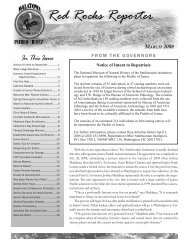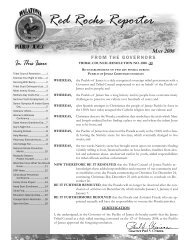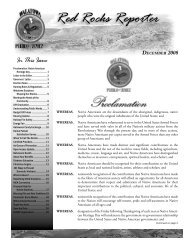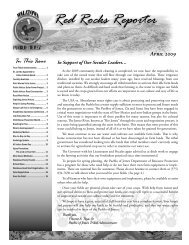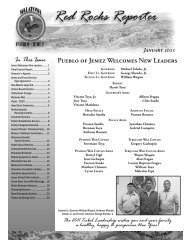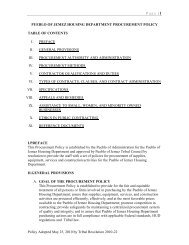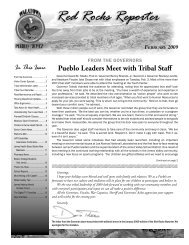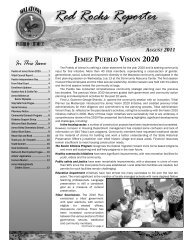Create successful ePaper yourself
Turn your PDF publications into a flip-book with our unique Google optimized e-Paper software.
<strong>Pueblo</strong> <strong>of</strong> <strong>Jemez</strong> Red Rocks Reporter <strong>March</strong> <strong>2012</strong> Page 4<br />
INJURY PREVENTION<br />
PROTECT YOUR HOME FROM FIRE!<br />
If you have a wood stove, the ONLY protection against accidental fires is to properly install<br />
and maintain it. Fire-resistant millboard, sheet metal or decorative brick placed on combustible<br />
walls or even walls protected by sheetrock provide little or no protection from radiant heat. Take<br />
time to make sure your home and family are protected!<br />
PROTECT YOUR HOME!<br />
Install a shield <strong>of</strong> 24-gauge sheet metal over UL approved fire-resistant millboard on the floor<br />
under the stove, extending six inches from the sides and back and 18 inches in front <strong>of</strong> the unit.<br />
The stove should have legs at least four inches high or the unit should be placed on masonry<br />
blocks with holes at the sides to allow air circulation under the stove.<br />
Follow the manufacturer’s specifications for clearances between the stove and a combustible<br />
wall or ceiling. A wall <strong>of</strong> wooden studs covered with sheetrock is a combustible wall.<br />
All open-front wood stoves or fireplaces must have screens.<br />
Do not overfill the stove or allow the fire to get too hot.<br />
CHIMNEYS<br />
Use TRIPLE-WALL STOVE PIPE ONLY. Secure each joint with three metal screws. A<br />
severe chimney fire can blow apart unsecured joints.<br />
Do not connect more than one heating device to a single chimney flue; poisonous gases or<br />
sparks may pass from one appliance out the other.<br />
Chimney pipes require proper clearances; check with the installation manual.<br />
Don't use fiberglass insulation. It is held together with a resin that vaporizes at 250°F. and falls<br />
apart when used as insulation near chimney pipes.<br />
Keep plastic or other combustible insulation away from chimney pipes. They can burn.<br />
The chimney should extend at least two feet higher than any point <strong>of</strong> the ro<strong>of</strong> within 10 feet <strong>of</strong><br />
the chimney pipe.<br />
OPERATIONS<br />
Never burn coal and wood in the same stove. Specifications for coal stoves are different<br />
because coal generates higher heat.<br />
Burn dry, well-seasoned wood that dried at least one year. This reduces creosote deposits.<br />
If you burn artificial logs, never burn more than one at a time or poke the log. They contain<br />
chemicals that burn very fast if broken up. This damages your stove and could cause a fire.<br />
Keep wood, paper, matches or other combustibles away from the wood stove or chimney pipe.<br />
When reloading the stove or starting a fire, let it burn with dampers wide open for five minutes.<br />
This will help burn out creosote deposits in the chimney. Warning: do not start a hot fire if<br />
there is a creosote layer 1/8 inch or more in the chimney pipe.<br />
Never use flammable or combustible liquids to kindle or rekindle a fire!<br />
Don’t burn trash, cardboard, milk cartons and Christmas wrap or similar materials that produce<br />
higher temperatures than normal fires.<br />
All wood fires produce creosote. Clean the chimney <strong>of</strong>ten and burn only seasoned dry wood to<br />
prevent flammable build-up.<br />
BE PREPARED<br />
Keep Class 1A:10BC dry chemical fire extinguishers in the kitchen and near the wood stove.<br />
Install smoke detectors in the kitchen, living areas and bedrooms.<br />
Did You Know?<br />
97% <strong>of</strong> the fire fatalities nationwide died <strong>of</strong> smoke inhalation without ever receiving a burn<br />
and 64% died in bed without ever knowing there was a fire.<br />
It has been estimated that one-third <strong>of</strong> these fatalities could have been prevented.<br />
The Injury Prevention Program has smoke alarms available for<br />
community residents. Call (575) 834-1001 for more information.<br />
Ditch Safety<br />
As we prepare for planting season,<br />
ditches will soon be flowing with<br />
water. The Injury Prevention Program<br />
reminds parents that ditches and<br />
arroyos can be deadly! Please tell your<br />
children to stay away from ditches. They<br />
should never play in ditches or throw<br />
anything in them. As community members,<br />
we treasure our ditches and want<br />
them clean to use for our crops.<br />
Safe Burning<br />
Burning to clear vegetation and debris<br />
can quickly become a dangerous wildfi re.<br />
Follow these safety tips to protect yourself,<br />
your home and your community.<br />
Get a Burn Permit<br />
Contact the tribal <strong>of</strong>fi ce to confi rm that<br />
burning is allowed and get a permit.<br />
Check the Weather Forecast<br />
Sudden changes in wind direction or<br />
speed could make a burning ditch into<br />
an out-<strong>of</strong>-control blaze.<br />
Prepare the Site Correctly<br />
The ground around the burn site must<br />
be surrounded by gravel or dirt for at<br />
least fi ve feet in all directions. Clear all<br />
vegetation before starting the burn.<br />
For larger areas, till around the fi eld to<br />
create a fi re break before burning.<br />
Make Sure the Site is Safe for Burning<br />
Sites should be far from power lines,<br />
gas lines, telephone boxes, buildings,<br />
vehicles, equipment and tree limbs.<br />
Open space above the fi re should be at<br />
least three times the height <strong>of</strong> the pile<br />
(nine feet clearance above a three-ft.<br />
pile.) Heat extends far past the fl ames.<br />
Stay with Your Burn<br />
Watch the smoke. Smoke can create<br />
a hazard when it blows across roads,<br />
limiting visibility.<br />
Stay at the burn site until the fi re is<br />
completely out. Drown the fi re with<br />
water or turn ashes with a shovel.<br />
Repeat several times. Check the area<br />
<strong>of</strong>ten for several days, especially if the<br />
weather is warm, dry and windy.<br />
Source: Southern <strong>Pueblo</strong>s Agency



